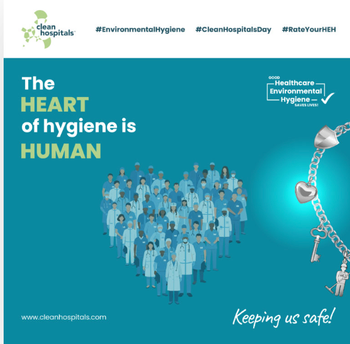
Infection Control Today - 01/2004: OR Topics
Skin Prep:
Preparing the Hypersensitive Patient
By Tina Brooks
Although anaphylaxis is rare, it isestimated that as many as 43 million people in the United States are at risk. The likelihood that one ofthese individuals will require a surgical procedure during their lifetime is areal possibility.
Anaphylaxis is a type I hypersensitivity reaction in which exposure of asensitized individual to a specific antigen results in hives, itching, andswelling, followed by blood vessel collapse and shock and often accompanied bylife-threatening respiratory distress.1 This condition may occur within secondsto minutes of exposure to the antigen. The quicker the reaction, the more severeit can be. In extreme cases, death may occur in 5 to 10 minutes after onset of the reaction.2
An anaphylactic reaction is considered a multisystem response, says Carolyn Twomey, RN, BSN, a clinical nurse consultant for Regent Medical.In addition to the typical allergic reactions such as hives, rhinitis,shortness of breath, and wheezing, one can have tachycardia, hypotension,laryngeal edema, cardiac arrest and even gastrointestinal symptoms.
Effective treatment is available as long as symptoms are quickly recognizedand handled promptly. Pretreatment of known hypersensitive patients hasntnecessarily guaranteed that anaphylaxis will not occur.
A reaction can be triggered by exposure to an allergen through inhalation,injection, ingestion or skin contact. Common causes of anaphylaxis includefoods, medications and insect stings. Products used during surgery, however, cancause anaphylaxis too, including those for skin preps.
Allergies in general have increased across the United States, says Wava Truscott, PhD, director of scientific affairs and clinicaleducation at Kimberly-Clark Health Care. Many of the products that we use inhealthcare contain some of the materials individuals are allergic to.
Skin Cleansing
The objective of a skin prep is to remove dirt, reduce microorganisms andprevent further microbial growth during a procedure. It is individualized to theclients needs, which are determined by health status and the type ofprocedure scheduled.
Whether using disposable trays or prepared sterile tables, the followingitems are usually required: towels, basins, sponges, gloves and an antisepticagent.
Some disposable sterile skin prep trays include applicators and or containers of a pre-measured amount of antiseptic solution.3 Antiseptics are the most frequent cause of contact dermatitis in patients undergoing surgery.4
As with any topical, there will be a certain percentage of the populationthat cannot use it, says Steve Owens, marketing director at Healthpoint Ltd.
Antiseptic agents have been known to trigger anaphylaxis as well. Those thatare frequently reported contain iodine and chlorhexidine. Initial exposure to these antiseptic agents may come from the use ofevery-day products such as hair dyes, gargles and toothpaste. A 64-year-old patient developed a life-threatening anaphylactic reactioncaused by povidone-iodine during induction of anesthesia for elective coronaryartery bypass graft surgery.5 There are a small but growing number of reports ofanaphylaxis to chlorhexidine administered by a variety of routes, includingintact skin, surgical wounds and immersion in a chlorhexidine bath.6
Occasionally, there may be individuals that are allergic to the soaps thattheyre asked to bathe with prior to surgery, but a full anaphylactic reactionwould be extremely rare, Truscott says.
Latex, which is a leading cause of anaphylaxis within the healthcare setting,may be present in gloves, applicators, and even adhesive tape. Allergicreactions to latex are often systemic responses to the proteins found in naturalrubber latex (NRL). For the general public, the risk of becoming latex allergicis estimated to be less than 1 percent with higher occurrences among childrenwith spina bifida or patients who have undergone multiple surgical procedures,reports the Food and Drug Administration (FDA). In one case, a woman with nopast medical history of allergies to medications, food or latex was found to belatex-sensitive during surgery, however, her multiple surgical procedures couldhave suggested the potential for such an adverse event.7
When we talk about latex allergy or any other allergy, consideration mustbe given to those individuals who are atopic somebody who is geneticallypreprogrammed, Twomey says. Those people who are genetically preprogrammedhave a greater propensity to develop allergies no matter what theyre exposedto.
Patients can be exposed preoperatively to this potential allergypromoting orskin-irritating substance used in connection with surgery.8 Remember that its not just their exposure in-house, but that exposure could happen in an outpatient surgery center, a podiatry office (ifthey have a procedure there) or even a dentist office, Twomey says. So, even if they dont come to a hospital frequently, iftheyve had frequent procedures or exposure to certain products or scrubs, itwould increase their potential to react to a product. Allergies occur because of exposure over time.
Patient Care
Avoidance of anaphylaxis requires an awareness of previous allergic reactionsin individuals and identification of those people who are likely to experience aserious reaction to any of the items used in preparing the patient for surgery.9Twomey suggests the use of an evaluation tool or decision tree, many of whichare available in the practice arena, to evaluate patients reactions that theyvehad historically.
Of special importance is the way in which questions are asked during theevaluation, says Milt Hinsch, technical director at Regent Medical. Forexample, if you ask somebody, Are you latex allergic? they may say a flatno. But if you ask, When you were a kid and blowing up balloons, didyour lips ever swell up? or When you wear rubber gloves and do the dishes,what happens? Those kinds of things suddenly take it from a no to Oh,yeah. I have had some reactions to latex products and things.
John Calhoun, product manger at Sempermed USA, recommends, Find out if thepatient has observed sensitivities to chemical accelerators or chemicalresiduals in gloves in addition to latex.
Twomey adds that she once had a patient that wasnt aware of having anyallergies. Yet, upon further questioning as to why the patient avoided certainfoods, it was discovered that the patient had an allergy to bananas. A lot oftimes people dont get diagnosed. They simply practice good avoidance. So, you have to be a good sleuth and getthat information.
Another critical component is communication between the surgeons officeand the surgical posting for a hospital. Surgeons should be verycommunicative about issues, questions or things theyve found when theyveasked their patients or taking their histories, says Twomey.
They should pass that information along so that you dont find yourself introuble in the OR. You can be proactive. But, that link is always a challenge.
Product Selection
Twenty to 30 years ago, we didnt have nearly the myriad of selectionsof products in the medical device field that we have today, Hinsch says. Today, somebody can easily go and find an alternative ifthere is a question of irritation or allergic reaction to a particular materialor product. There are many options.
Experts agree that the key to proper selection of items used for a skin prepinvolves product education. You have to be very discerning and knowledgeable about the equipment youuse, and if we are talking about scrubs or preps, you have to know theinformation about the active ingredients to understand the product, Twomeysays.
Owens suggests that clinicians seek prep alternatives that may not includesome of the known allergens such as iodine or CHG (chlorhexidine gluconate).
With regard to gloves, One of the biggest things is to understand latexand these different materials used in gloves. People really dont understandthe nature of the materials. That is the first part of educating themselves onwhat these materials are and how they could affect the patient, Calhoun says.
It is important not to inadvertently introduce new complications withselected gloves, says Truscott. Could substances penetrate the glove,causing health concerns for the wearer? Would it break down during use?
Tito Aldape, vice president of regulatory and scientific affairs at MicroFlexCorp., says, The one-glove-fits-all notion is a big misconception. There are many different types of medical gloves and glove needs in themarketplace. Clinicians, for example, have specific hand protection needs the glove selection process must consider the application for which the glove isintended to be used. The risk manager has to consider employee health and safety, again taking thespecific work function, task, and medical glove application into considerationbefore recommending a particular medical glove. The quality of the medical gloveis very important and needs to be considered heavily. Not all medical gloves arecreated equal and can vary significantly in overall quality. Clinicians shouldalso request that their medical glove supplier provide them with documentationthat the medical gloves they are purchasing meet current regulatory requirementsand current performance standards. One such document that should be requested isa certificate of compliance.
Owens emphasizes, In general, the one thing that clinicians want to makesure of is that they can maximize or provide the highest levels of efficacy inconjunction with providing a product that offers the lowestsensitivities/allergic properties or irritation opportunities.
Did You Know...
The Internet offers a wealth of information on anaphylaxis. Here is a list ofWeb sites to investigate for more information:
- American Academy of Allergy,Asthma & Immunology Provides the general publicand professionals with the latest information for a variety of allergicconditions, including anaphylaxis.
www.aaaai.org
- AmericanSociety of Anesthesiologists Offers a number ofarticles discussing latex allergy, anaphylaxis and the role of theanesthesiologist.
www.asahq.org
- Annals of Internal Medicine Providespatients a summary of delayed drug hypersensitivity reactions for educationalpurposes only. The journal also allows access to previously published articles.
www.annals.org/cgi/content/full/139/8/I-46
- eMedicine Provides clinical knowledgebased articles onanaphylaxis for physicians and health professionals.
www.emedicine.com
- Food Allergy and AnaphylaxisAlliance Presents facts about food allergy and relatedissues from the perspective of various countries: Australia, Canada, NewZealand, Netherlands, United Kingdom and United States.
www.foodallergyalliance.org
- Food Allergy andAnaphylaxis Alliance Provides information andresources to the general public and professionals about various issuessurrounding anaphylaxis.
www.foodallergy.org
- Foodand Nutrition Information Center Provides severallinks to other Web sites offering information about allergies and foodsensitivities.
http://www.nal.usda.gov/fnic/etext/000004.html
- National Institute of Infectious Diseases Presents anaphylaxis and allergy statistics in the United States. Reference sources are provided.
www.niaid.nih.gov/factsheets/allergystat.htm
- PubMed Lists several citations for biomedical articles fromMEDLINE and additional life science journals. PubMed includes links to manysites providing full text articles and other related resources.
www.ncbi.nih.gov/entrez/query.fcgi
- U.S. Food andDrug Administration Offers several articles aboutanaphylaxis, latex allergy, drugs and related issues.
www.fda.gov
Newsletter
Stay prepared and protected with Infection Control Today's newsletter, delivering essential updates, best practices, and expert insights for infection preventionists.





